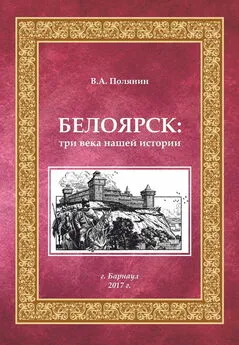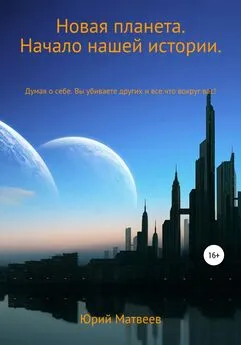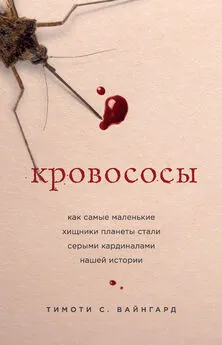Тимоти С Вайнгард - Кровососы [Как самые маленькие хищники планеты стали серыми кардиналами нашей истории] [litres]
- Название:Кровососы [Как самые маленькие хищники планеты стали серыми кардиналами нашей истории] [litres]
- Автор:
- Жанр:
- Издательство:Литагент 5 редакция «БОМБОРА»
- Год:2019
- Город:Москва
- ISBN:978-5-04-100194-0
- Рейтинг:
- Избранное:Добавить в избранное
-
Отзывы:
-
Ваша оценка:
Тимоти С Вайнгард - Кровососы [Как самые маленькие хищники планеты стали серыми кардиналами нашей истории] [litres] краткое содержание
Кровососы [Как самые маленькие хищники планеты стали серыми кардиналами нашей истории] [litres] - читать онлайн бесплатно ознакомительный отрывок
Интервал:
Закладка:
Poinar, George, Jr., and Roberta Poinar. What Bugged the Dinosaurs: Insects, Disease, and Death in the Cretaceous. Princeton: Princeton University Press, 2008.
Powell, J. H. Bring Out Your Dead: The Great Plague of Yellow Fever in Philadelphia in 1793. Philadelphia: University of Pennsylvania Press, 1993.
Quammen, David. Spillover: Animal Infections and the Next Human Pandemic. New York: W. W. Norton, 2012.
Rabushka, Alvin. Taxation in Colonial America. Princeton: Princeton University Press, 2008.
Reff, Daniel T. Plagues, Priests, and Demons: Sacred Narratives and the Rise of Christianity in the Old World and the New. Cambridge: Cambridge University Press, 2005.
Regalado, Antonio. «The Extinction Invention». MIT Technology Review (April 13, 2016). https://www.technologyreview.com/s/601213/the-extinction-invention/.
Regalado, Antonio. «Bill Gates Doubles His Bet on Wiping Out Mosquitoes with Gene Editing». MIT Technology Review (September 6, 2016). https://www.technologyreview.com/s/602304/bill-gates-doubles-his-bet-on-wiping-out-mosquitoes-with-gene-editing/.
Regalado, Antonio. «US Military Wants to Know What Synthetic-Biology Weapons Could Look Like.» MIT Technology Review (June 19, 2018). https://www.technologyreview.com/s/611508/us-military-wants-to-know-what-synthetic-biology-weapons-could-look-like/.
Reich, David. Who We Are and How We Got Here: Ancient DNA and the New Science of the Human Past. New York: Pantheon, 2018.
Reilly, Benjamin. Slavery, Agriculture, and Malaria in the Arabian Peninsula. Athens: Ohio University Press, 2015.
Riley-Smith, Jonathan. The Crusades: A History. London: Bloomsbury Press, 2014.
Roberts, Jonathan. «Korle and the Mosquito: Histories and Memories of the Anti-Malaria Campaign in Accra, 1942–1945». Journal of African History 51:3 (2010): 343–365.
Rocco, Fiammetta. The Miraculous Fever-Tree: Malaria, Medicine and the Cure That Changed the World. New York: HarperCollins, 2003.
Rockoff, Hugh. America’s Economic Way of War: War and the US Economy from the Spanish-American War to the Persian Gulf War. Cambridge: Cambridge University Press, 2012.
Rogers, Guy MacLean. Alexander: The Ambiguity of Greatness. New York: Random House, 2005.
Romm, James. Ghost on the Throne: The Death of Alexander the Great and the Bloody Fight for His Empire. New York: Vintage, 2012.
Rosen, Meghan. «With Dinosaurs Out of the Way, Mammals Had a Chance to Thrive». Science News 191:2 (2017): 22–33.
Rosenwein, Barbara. A Short History of the Middle Ages. Toronto: University of Toronto Press, 2014.
Roy, Rohan Deb. Malarial Subjects: Empire, Medicine and Nonhumans in British India, 1820–1909. Cambridge: Cambridge University Press, 2017.
Russell, Paul F. Man’s Mastery of Malaria. London: Oxford University Press, 1955.
Saey, Tina Hesman. «Gene Drives Unleashed». Science News (December 2015): 16–22.
Satho, Tomomitsu, et al. «Coffee and Its Waste Repel Gravid Aedes albopictus Females and Inhibit the Development of Their Embryos.» Parasites & Vectors 8:272 (2015).
Sallares, Robert. Malaria and Rome: A History of Malaria in Ancient Italy. Oxford: Oxford University Press, 2002.
Schantz, Mark S. Awaiting the Heavenly Country: The Civil War and America’s Culture of Death. Ithaca, NY: Cornell University Press, 2008.
Scott, Susan, and Christopher J. Duncan. Biology of Plagues: Evidence from Historical Populations. Cambridge: Cambridge University Press, 2001.
Servick, Kelly. «Winged Warriors». Science (October 2016): 164–167.
Shah, Sonia. The Fever: How Malaria Has Ruled Humankind for 500,000 Years. New York: Farrar, Straus and Giroux, 2010.
Shah, Sonia. Pandemic: Tracking Contagions, from Cholera to Ebola and Beyond. New York: Farrar, Straus and Giroux, 2016.
Shannon, Timothy, ed. The Seven Years’ War in North America: A Brief History with Documents. New York: Bedford-St. Martin’s Press, 2014.
Shaw, Scott Richard. Planet of the Bugs: Evolution and the Rise of Insects. Chicago: University of Chicago Press, 2015.
Sherman, Irwin W. The Power of Plagues. Washington, DC: ASM Press, 2006.
Sherman, Irwin W. Twelve Diseases That Changed Our World. Washington, DC: ASM Press, 2007.
Shore, Bill. The Imaginations of Unreasonable Men: Inspiration, Vision, and Purpose in the Quest to End Malaria. New York: Public Affairs, 2010.
Singer, Merrill, and G. Derrick Hodge, eds. The War Machine and Global Health. New York: Alta Mira Press, 2010.
Slater, Leo B. War and Disease: Biomedical Research on Malaria in the Twentieth Century. New Brunswick, NJ: Rutgers University Press, 2014.
Smith, Billy G. Ship of Death: A Voyage That Changed the Atlantic World. New Haven: Yale University Press, 2013.
Smith, Joseph. The Spanish-American War: Conflict in the Caribbean and the Pacific, 1895–1902. New York: Taylor & Francis, 1994.
Snow, Robert W., Punam Amratia, Caroline W. Kabaria, Abdisaian M. Noor, and Kevin Marsh. «The Changing Limits and Incidence of Malaria in Africa: 1939–2009». Adv Parasitol 78 (2012): 169–262.
Snowden, Frank M. The Conquest of Malaria: Italy, 1900–1962. New Haven: Yale University Press, 2006.
Soren, David. «Can Archaeologists Excavate Evidence of Malaria?». World Archaeology 35:2 (2003): 193–205.
Specter, Michael. «The DNA Revolution: With New Gene-Editing Techniques, We Can Transform Life – But Should We?» National Geographic (August 2016): 36–55.
Spencer, Diana. Roman Landscape: Culture and Identity. Cambridge: Cambridge University Press, 2010.
Spielman, Andrew, and Michael D’Antonio. Mosquito: A Natural History of Our Most Persistent and Deadly Foe. New York: Hyperion, 2001.
Srikanth, B. Akshaya, et al. «Chloroquine-Resistance Malaria». Journal of Advanced Scientific Research 3:3 (2012): 11–14.
Standage, Tom. A History of the World in 6 Glasses. New York: Walker, 2005.
Steiner, Paul E. Disease in the Civil War: Natural Biological Warfare in 1861–1865. Springfield, IL: Charles C. Thomas, 1968.
Stepan, Nancy Leys. Eradication: Ridding the World of Diseases Forever? Ithaca: Cornell University Press, 2011.
Strachan, Hew. The First World War in Africa. Oxford: Oxford University Press, 2004.
Stratton, Kimberly B., and Danya S. Kalleres, eds. Daughters of Hecate: Women and Magic in the Ancient World. Oxford: Oxford University Press, 2014.
Stromberg, Joseph. «Why Do Mosquitoes Bite Some People More Than Others?» Smithsonian magazine (July 2013). https://www.smithsonianmag.com/science-nature/why-do-mosquitoes-bite-some-people-more-than-others-10255934/.
Sugden, John. Nelson: A Dream of Glory, 1758–1797. New York: Henry Holt, 2004.
Sutter, Paul S. «Nature’s Agents or Agents of Empire? Entomological Workers and Environmental Change during the Construction of the Panama Canal». Isis 98:4 (2007): 724–754.
Sverdrup, Carl Fredrik. The Mongol Conquests: The Military Operations of Genghis Khan and Sübe’etei. Warwick, UK: Helion, 2017.
Tabachnick, Walter J., et al. «Countering a Bioterrorist Introduction of Pathogen-Infected Mosquitoes through Mosquito Control». Journal of the American Mosquito Control Association 27:2 (2011): 165–167.
Taylor, Alan. The Civil War of 1812: American Citizens, British Subjects, Irish Rebels, and Indian Allies. New York: Alfred A. Knopf, 2010.
Than, Ker. «King Tut Mysteries Solved: Was Disabled, Malarial, and Inbred». National Geographic (February 2010). https://news.nationalgeographic.com/news/2010/02/100217-health-king-tut-bone-malaria-dna-tutankhamun/.
Thurow, Roger, and Scott Kilman. Enough: Why the World’s Poorest Starve in an Age of Plenty. New York: Public Affairs, 2009.
Townsend, John. Pox, Pus & Plague: A History of Disease and Infection. Chicago: Raintree, 2006.
Tyagi, B. K. The Invincible Deadly Mosquitoes: India’s Health and Economy Enemy #1. New Delhi: Scientific Publishers India, 2004.
Uekotter, Frank, ed. Comparing Apples, Oranges, and Cotton: Environmental Histories of Global Plantations. Frankfurt: Campus Verlag, 2014.
US Army 45th Division. The Fighting Forty-Fifth: The Combat Report of an Infantry Division. Edited by Leo V. Bishop et al. Baton Rouge: Army & Navy Publishing Company, 1946.
US Army Infantry Regiment 157th. History of the 157th Infantry Regiment: 4 June ’43 to 8 May ’45. Baton Rouge: Army & Navy Publishing Company, 1946.
Van Creveld, Martin. The Transformation of War. New York: Free Press, 1991.
Van den Berg, Henk. «Global Status of DDT and Its Alternatives for Use in Vector Control to Prevent Disease». United Nations Environment Programme: Stockholm Convention on Persistent Organic Pollutants UNEP/POPS/DDTBP.1/2 (October 2008): 1–31.
Vandervort, Bruce. Indian Wars of Mexico, Canada, and the United States, 1812–1900. New York: Routledge, 2006.
Vosoughi, Reza, Andrew Walkty, Michael A. Drebot, and Kamran Kadkhoda. «Jamestown Canyon Virus Meningoencephalitis Mimicking Migraine with Aura in a Resident of Manitoba». Canadian Medical Association Journal 190:9 (March 2018): 40–42.
Watson, Ken W. «Malaria: A Rideau Mythconception». Rideau Reflections (Winter/Spring 2007): 1–4.
Watts, Sheldon. Epidemics and History: Disease, Power and Imperialism. New Haven: Yale University Press, 1997.
Weatherford, Jack. Genghis Khan and the Making of the Modern World. New York: Broadway Books, 2005.
Webb, James L. A., Jr. Humanity’s Burden: A Global History of Malaria. Cambridge: Cambridge University Press, 2009.
Weil, David N. «The Impact of Malaria on African Development over the Longue Durée». In Africa’s Development in Historical Perspective, edited by Emmanuel Akyeampong et al., 89–111. Cambridge: Cambridge University Press, 2014.
Weisz, George. Chronic Disease in the Twentieth Century: A History. Baltimore: Johns Hopkins University Press, 2014.
Weiyuan, Cui. «Ancient Chinese Anti-Fever Cure Becomes Panacea for Malaria». Bulletin of the World Health Organization 87 (2009): 743–744.
Welsh, Craig. «Why the Arctic’s Mosquito Problem Is Getting Bigger, Badder». National Geographic, September 15, 2015. https://news.nationalgeographic.com/2015/09/150915-Arctic-mosquito-warming-caribou-Greenland-climate-CO2/.
Wernsdorfer, Walther H. Malaria: Principles and Practice of Malariology. Edited by Ian McGregor. London: Churchill Livingstone, 1989.
Wheeler, Charles M. «Control of Typhus in Italy 1943–1944 by Use of DDT». American Journal of Public Health 36:2 (February 1946): 199–129.
White, Richard. The Middle Ground: Indians, Empires, and Republics in the Great Lakes Region, 1650–1815. Cambridge: Cambridge University Press, 1991.
Whitlock, Flint. The Rock of Anzio: From Sicily to Dachau: A History of the U.S. 45 thInfantry Division. New York: Perseus 1998.
Wild, Antony. Coffee: A Dark History. New York: W. W. Norton, 2005.
Willey, P., and Douglas D. Scott, eds. Health of the Seventh Cavalry: A Medical History. Norman: University of Oklahoma Press, 2015.
Williams, Greer. The Plague Killers. New York: Scribner, 1969.
Winegard, Timothy C. Indigenous Peoples of the British Dominions and the First World War. Cambridge: Cambridge University Press, 2011.
Winegard, Timothy C. The First World Oil War. Toronto: University of Toronto Press, 2016.
Winther, Paul C. Anglo-European Science and the Rhetoric of Empire: Malaria, Opium, and British Rule in India, 1756–1895. New York: Lexington Books, 2003.
World Health Organization. Annual Reports; Data and Fact Sheets; Mosquito Borne Diseases. Http://www.who.int/news-room/fact-sheets.
World Health Organization. Guidelines for the Treatment of Malaria. 3 rded. Rome: WHO, 2015.
Читать дальшеИнтервал:
Закладка:
![Обложка книги Тимоти С Вайнгард - Кровососы [Как самые маленькие хищники планеты стали серыми кардиналами нашей истории] [litres]](/books/1072082/timoti-s-vajngard-krovososy-kak-samye-malenkie-h.webp)
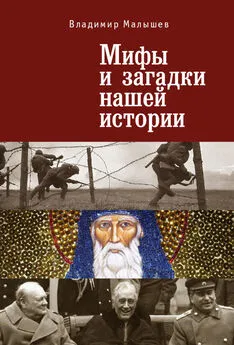
![Дэн Бюттнер - Где живет счастье [Правила жизни самых счастливых людей планеты] [litres]](/books/1065925/den-byuttner-gde-zhivet-schaste-pravila-zhizni-samyh.webp)
![Келси Миллер - Друзья. Больше, чем просто сериал [История создания самого популярного ситкома в истории] [litres]](/books/1073323/kelsi-miller-druzya-bolshe-chem-prosto-serial-is.webp)
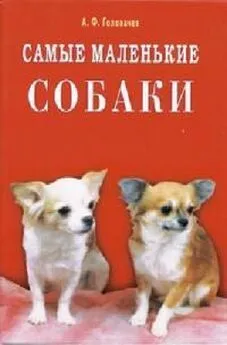
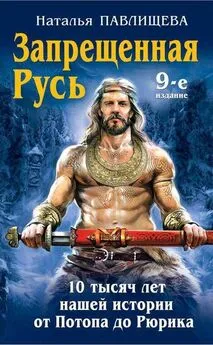
![Медина Мирай - Зазеркалье Нашей Реальности [litres]](/books/1143348/medina-miraj-zazerkale-nashej-realnosti-litres.webp)
